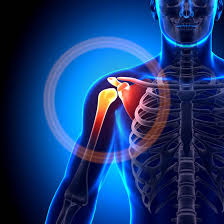Shoulder Pain And How To Treat It
- David Polomie
- Oct 25, 2022
- 4 min read
So, you have aching shoulders and you're not sure if its injury, tear, impingement, arthritis or just old age. Read ahead and I hope this article sheds some light on the injury.
Some shoulder conditions may become more common as you age. So, I would guess to say that most us don't think much about our health and where our bodies are taking us as we age. The shoulders being a ball-and-socket joint gets alot of use and abuse. If you have ever experienced shoulder pain (Umm...I have) you know it can be quite unbearable. Shoulder pain can make a simple act, like, brushing and drying your hair, reaching behind your back to fasten a bra, or grabbing something overhead — seem like an overbearing task. As we age, we are more likely to experience shoulder pain from a variety of conditions. The pain can come on gradually or abruptly, and it could range from just mild pain to an excruciating, face gringing pain, "OUCH! that really hurts" pain. Here are some of the most common conditions you may experience, and some tips for how to treat them.
What to do if your shoulder hurts?
If you do experience shoulder pain, it's sometimes difficult to figure out the root cause. Many times there are pre existing conditions in other parts of the body that are actually the source of the pain, which then radiates to your shoulder. For instance, this may occur with certain neck conditions, including arthritis and disc herniations. In general, if you are experiencing conditions like these, it's best to see a doctor immediately to have your shoulder condition diagnosed. But if you have mild shoulder pain, you can sometimes try adjusting your activities, taking anti-inflammatory supplements, such as tumeric curcumin, fish oil, ginger, resveratrol, spirulina, vitamin D, bromelain, green tea, garlic, vitamin C and performing mild stretches to see if the pain improves on its own. However, if the pain is getting worse or doesn't go away after a few weeks, you should consult your doctor.
What About Rotator Cuff Injuries?
Your rotator cuff is a group of muscles and tendons that help connect your shoulder into the socket and allow you to move it in a rotational (circle) motion. Rotator cuff and shoulder injuries seem to more prevalent in people over the age if 40. Approximately two million people visit a doctor each year for rotator cuff–related issues, according to the American Academy of Orthopedic Surgery (AAOS). Typically the injuries usually fall into two categories: tears or inflammation.
How to know if you have rotator cuff impingement?
A rotator cuff impingement happens when there is irritation, inflammation, or compression of the tendons or bursa (the fluid-filled sac that sits between bones) in the shoulder. An impingement can be caused by either an injury or as a result from general wear and tear from daily life.
Rotator cuff tears. A tear in the rotator cuff will produce pain that is similar to an impingement but has one additional differentiating feature. If the pain is associated with weakness, it is likely caused by a tear, and if you just have pain, it may only be a rotator cuff impingement.
Compared with impingement, a tear is more likely to be caused by an injury. Some common causes include falling on concrete or a very hard surface, getting pulled by a dog on a leash, or trip that may cause to land directly on your shoulder.
At any rate, if you believe you may have a tear or are experiencing pain from an injury, see your doctor right away, because you may need surgery to fix the problem. However, if you are not experiencing weakness and the pain does not seem severe, then its advised to rest and to take your anti-inflammatory supplements (see above).
Stretching exercises to maintain healthy shoulders
Seated shoulder stretch
*Primarily stretches the shoulder
Reps: 2–4Hold: 10–30 seconds
Starting position: Sit up straight on a chair. Put your left hand on your right shoulder. Cup your left elbow with your right hand.
Movement: Roll your shoulders down and back, then gently pull your left elbow across your chest as you extend your left arm. Feel the stretch in your left shoulder. Hold. Return to the starting position, then repeat on the opposite side. This is one rep.
Seated triceps stretch
*Primarily stretches the back of the upper arm and the shoulder
Reps: 2–4Hold: 10–30 seconds
Starting position: Sit up straight. Place your right hand on your right shoulder. Clasp your right elbow with your left hand.
Movement: Keeping your shoulders down and back, lift your right elbow up toward the ceiling to the point of tightness. Feel the stretch in the back of your upper right arm and shoulder. Hold. Return to the starting position. Repeat on the other side. This is one rep.
Seated chest stretch
*Primarily stretches the chest and shoulders
Reps: 2–4Hold: 10–30 seconds
Starting position: Sit up straight facing sideways in a chair without arms.
Movement: Roll your shoulders down and back. Clasp your hands behind you, intertwining your fingers so your palms face you. Gently lift your hands toward the ceiling to the point of tightness. Feel the stretch in the front of your shoulders and across your chest. Hold. Slowly return to the starting position.
Remember, to always use discretion while performing your stretching exercises. If anything hurts while stretching back off or discontinue the particular stretch.








Comments